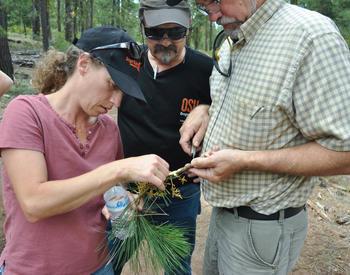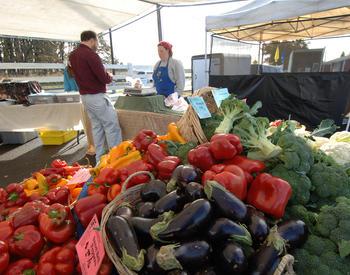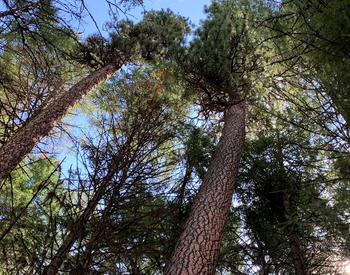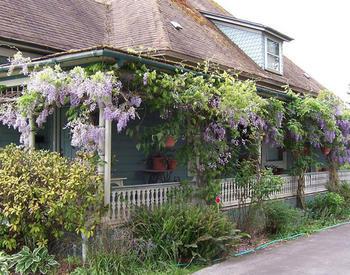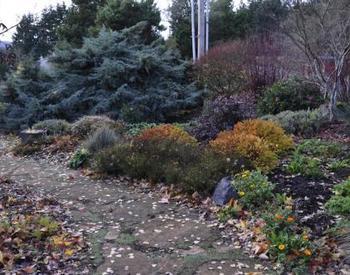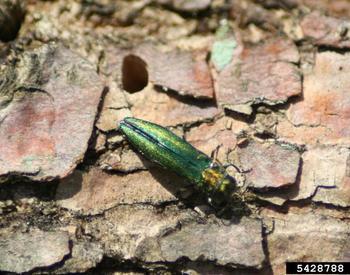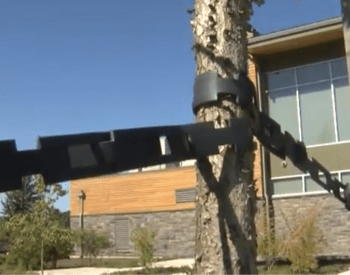ROSEBURG, Ore. – With distinctive peeling bark and statuesque form madrone trees play an iconic role in the Pacific Northwest landscape. Whether they are growing at the northern end of their range in British Columbia or south to San Diego, madrones are the type of tree that you forever recognize once you see one.
Madrones (Arbutus menziesii) aren’t as attractive, though, when diseases cause tip dieback, cankers on the trunk and, sometimes death. About 20 years ago some madrones in Washington – both in home landscapes and in the wild – showed signs of disease. Soon the problem appeared in Oregon, along the coast and inland to the Rogue and Willamette valleys and up into the foothills.
Over the years the diseases waxed and waned. But in 2022 Alicia Christiansen, Oregon State University Forestry and Natural Resources Extension agent and associate professor of practice in the College of Forestry, began to get calls.
Lots of calls.
“It was a wet spring, perfect for foliar diseases to pop up,” Christiansen said. “People saw the damage and got concerned and started asking a lot of questions. It got me thinking that I should do a workshop. We needed to get education out about this tree and its health issues.”
Interest was confirmed when 70 people showed up for All About Arbutus: A workshop covering Pacific madrone from A to Z. Terry Nightingale drove the distance from Seattle to Roseburg because he’d been to one presentation in Washington and wanted to delve deeper into the subject. He has an overgrown hill at the back of his urban lot that’s made up of clay soil with a deeper level that’s always moist. He’d like to plant madrones there.
“They are really beautiful; one of the trees that really stand out in the Northwest,” said Nightingale, who is a member of the advocate group Arbutus ARME, an organization that actively advocates for madrones. “They give me a feeling of home. It’s my fantasy to have Arbutus there, madrones up there keeping the slope from sliding down.”
That could be a problem. Madrones are notoriously difficult to propagate, and they demand well-draining soil, said Dave Shaw, OSU Forestry and Natural Resources Extension forest health specialist and professor in the College of Forestry. Much of the damage comes from Phytophthora – a species of common microorganisms, one of which caused the potato blight in Ireland in the 1840s when 1 million people died and another 1 million fled.
Phytophthora disease appears worldwide and is the number one disease of nursery crops in the United States. The list of species affected by the Phytophthora disease is long and includes popular plants like rhododendron, daphne, dogwood, camellia and apple. Madrone is also on the list.
Joining Christiansen and Shaw at the workshop were Marianne Elliott, a plant pathologist at Washington State University, and Michael Yadrick from Seattle City Parks. Elliott presented a segment on Phytophthora – whose name means “plant destroyer” – which is most common in irrigated areas such as urban settings and irrigated nursery stock. But it’s made itself at home in the wild, as well. The number of diseases that affect madrone is lengthy and the individual cases are difficult to identify. Symptoms appear as leaf spotting, twig dieback and cankers on the trunk.
“The more we use molecular techniques to identify fungi we realize that field diagnosis is problematic,” Shaw said. “We need to gather the fungi and take it back to the lab. That is a lot of work and takes money. Funding for madrone research is miniscule compared to commercial species like Douglas-fir.”
There are some things to do if a tree is suspected to have Phytophthora or one of the many fungi that affect madrones. Shaw advises growing madrones in full or almost-full sun, pruning off any black branches and raking up leaves and disposing of them. Cleaning tools as you work is important. Irrigation for these drought-tolerant trees is not needed; in fact, water can encourage disease. Find more information in the Extension publication “Forest Health Fact Sheet: Diseases and Insect Pests of Pacific Madrone.” Also, WSU has a website on madrone.
Climate change a disease factor
The diseases that plague madrones have been with us for a long time, but environmental conditions make disease more severe, Elliott said.
“The diseases have been here,” Elliott said. “The pessimism people have now is that they look so bad. I hear a lot of that, but in most years they look fine. Certain problems are worse some years. The difference is climate change and urbanization. It’s having an effect. Hot, summers – drought – causes root disease and stem cankers to be really aggressive and can cause dieback.”
Indeed, climate change has a role as does the tree’s microclimate, she said. In the forest under big Douglas-fir it would be too humid and would encourage disease. They prefer and will stay healthier in open spaces, and healthy trees are more equipped to fend off diseases.
Steve Hart, who has 40 madrones growing on five acres in the Melrose area near Roseburg, is one of those who are concerned about the tree. Hart bought the property in 2004 and in the last couple of years, which have been bad for disease, he lost five or six large trees. He came to see if there’s anything to do for the remaining trees and left the workshop with some information and tools to help.
That’s the response Christiansen was hoping for.
“I think they went away feeling more empowered to grow the species,” Christiansen said. “They came excited and went away with the knowledge to manage them. Madrones are known for being difficult to grow so people were glad to hear from experts, so they have the knowledge to try these techniques on their property.”
